A final year project on “IoT Based Firefighting System To Protecting Farm” was submitted by Aditi Kulkarni (from ATS SBGI, Miraj) to extrudesign.com.
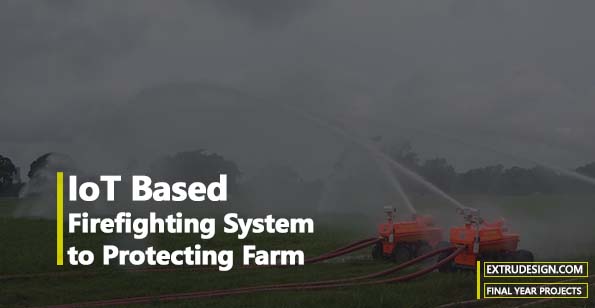
Abstract
Agriculture assumes an essential part in the economy of non-industrial nations, and gives the primary wellspring of food, pay and work to their provincial populations. Farmers hold the foundation of the farming framework. Agribusiness is the world’s driving wellspring of food items. In the summer season, a considerable lot of homesteads are dry and plants additionally dry there is loads of likelihood to happening ranch fire in ranch because of man-made like, impede power dissemination line, terminating stubble by humans. Because of that activity ranches are influenced seriously. This can make an influence on additional development seasons. We are building a brilliant framework that is controlled by IoT based which will shield our homestead from fire. At the point when a fire happens in encompassing homesteads then our framework will detect the fire and start water sprinklers to extinguish the fire and offer this information on IoT to know the situation with the ranch to the farmer. We additionally doing robotization utilizing IOT based water system framework.
We accomplishing this controlling framework worldwide by utilizing IOT based innovation.
Keywords— Firefighting System, IOT base firefighting system, Fire Alert system, IoT alter systems, Irrigation system.
Introduction
Agriculture in India constitutes more than 60% of the occupation. It serves to be the backbone of the Indian economy. It is very essential to improve the productivity and efficiency of crops and soil in agriculture. But as we have seen in the latest news in India and other countries these farm fire accidents are very dangerous. It will burn all the crops and also damage the soil it make soil erosion. These accidents are man-made accidents like electricity line faults and other kinds of mistakes. There is not any existing system to take immediate action for the prevention
from this fire. So we are building a system that is tackling this condition. We use farm water to take action.
In this system, we put sprinkles on all sides of the farm with flam sensors that sense the fire and give input to the microcontroller. The microcontroller will take proper action to put out this fire from the farm. This system is IoT based system so when the fire is sensed system will warn u very immediately. Because of IoT, we can monitor this anywhere.
Water is the existence of plants and should be supplied in a legitimate amount. The greater part of the dirt get
water through the downpour additionally water is added by the method of the water system from well, tank or waterway, and so on as well
much water may choke out plants roots and little will most likely be unable to support the plants. Excess is water is unsafe to edit and soil. Practically all parts of human existence have gone through quick improvement is upheld by the development of electronic and data technology. Automation of keen framework is the pith of the present world. The programmed water level control is a model for a shrewd system. The framework will mechanize the cycle by setting a solitary sensor in the ranch or in a framework that will occasionally take an estimation of the water level. This computerization has been done utilizing IoT based water system framework control.
Review of Literature
- Noor Aboor Khaleq, IoT based fire recognition framework. The Node of MCU is the open wellspring of the IoT stage.It is the fuses firmware which continue to run on the ESP8266 Wi-Fi SoC from Espressif Systems, and the gear which relies upon ESP-12 module.NodeMCU takes after brand name of a board that has a wifi module ESP8266 and some connected circuit.ESP8266 module all together has a more limited size regulator with wifi. You can program ESP8266 using Arduino,NodeMCU IDE or ESP8266 SDK.NodeMCU is improvement board for ESP8266, which is wifi chip with 32bit microcontroller.The ESP8266 has 17 GPIO pins (0- 16), in any case, you can simply use 11 of them, since 6 pins (GPIO 6 – 11) are used to relate the flash memory chip.
- Vardaan Mittal, We this study, this is an Arduino based automatic water level controller and indicator project. Here, we are going to measure the water level by using help of water sensor. The motor pump automatically turns ON when the water level is high. Actually there is a lot of rain water crisis in India and also in other countries .In this project I Am going to implement automatic water level control so that we no longer have to manually switch ON and OFF the motor. This helps in improve the crop wastage as well as soil and reduce manpower.
- Srishti Rawal, IoT based property water framework system, IOT is used to keep the farmers invigorated about the circumstance with sprinklers.Information from the sensors is reliably revived on a site page using GSM- GPRS SIM900A modem through which a farmer can check whether the water sprinklers are ON/OFF at some arbitrary time. Furthermore, the sensor readings are shipped off a Thing talk channel to deliver outlines for examination.
Problem Statement
The proposed system is designed to automate the system using Arduino and Node MCU. Node MCU will give us worldwide connectivity with farms. The interface of the sensor and the microcontroller is very user friendly which make it easy to operate for us. Daily monitoring data will be shown on our mobile phone that’s very useful to make advance agriculture.
Objectives
The objectives of this IoT based Firefighting System project are given below:
- Provide highly sensitive flam detection.
- Provide rapid and quick action of water sprinklers.
- Provide IoT based irrigation system
IoT based Firefighting System Architecture
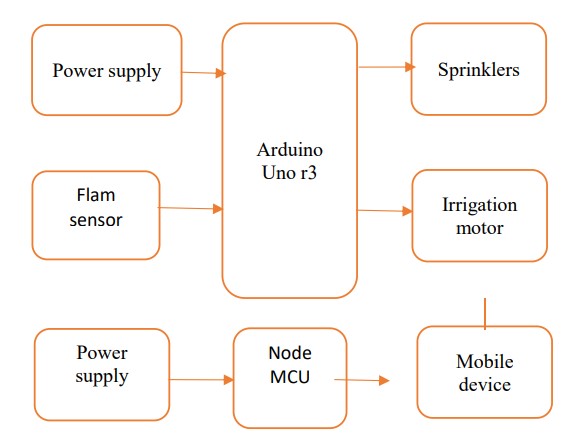
Working Of Sensors :-
Following are the sensors that we have used in the IoT Based Firefighting System To Protecting Farm.
1. Temperature Sensor
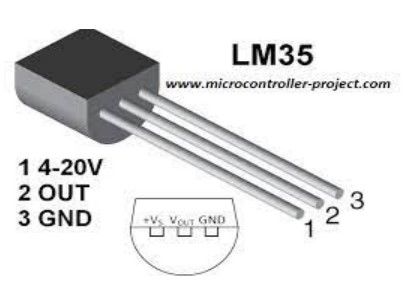
- The basic principle of working of the temperature sensors is the voltage across the diode terminals.
- If the voltage increases, the temperature also rises, followed by a voltage drop between the transistor terminals of the base and emitter in a diode.
2. Arduno Uno r3
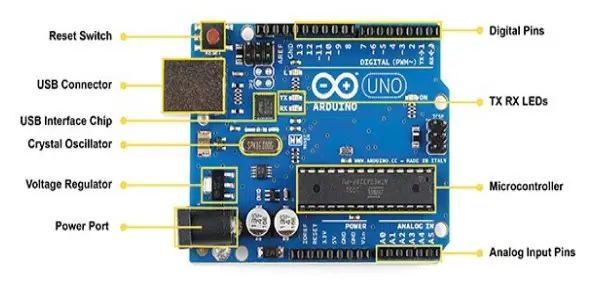
- IT has 14 electronic information/yield pins of which 6 can be used as outputs and 6 can be used as key information sources.
- The R3 is the third and latest, revision of the Arduino Uno.
- Arduino Uno is a microcontroller board subject to the ATmega328.
- It basically interfaces with a PC with a USB affiliation or power it with an AC-to-DC connector to start.
- In this project temperature sensor is associated at the I/p side
- of the microcontroller and the motor driver is associated o/p side of the microcontroller.
- The operating voltage of the Arduino is 5v. The proposed I/p voltage goes from 7v to 12v.
3. Relay
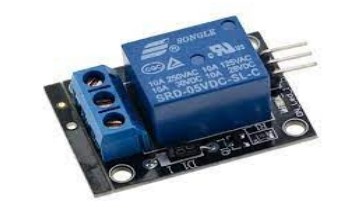
- The IoT Power Relay is a controllable power move outfitted with four yields that help you with making an Internet of Things project with secured, trustworthy power control.
- With the IoT Power Relay, you can without a doubt control the power going to a contraption with an Arduino, Raspberry Pi or other single-board PC or microcontroller.
- The IoT Power Relay is expected to allow you to safely control an outlet contraption that works at 3- – 48VDC or 12- – 120VAC.
4. Node MCU Action
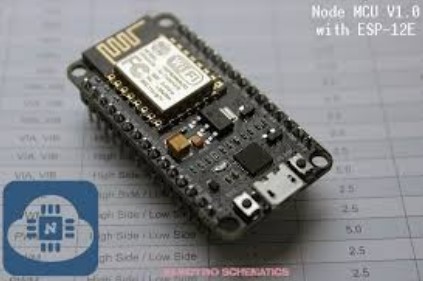
- Node MCU is an open-source and low-cost IoT platform. It is initially included firmware that runs on the ESP8266 wifi and hardware based on the ESP-12 module.
- Node MCU ESP8266 development board comes with the ESP- 12E module containing ESP8266 chip having 32- bit microprocessor.
- This microprocessor operates from 80 MHZ to 160 MHZ.
- Node MCU has 128 KB RAM and 4 MB of flash memory to store data.
- Firmware is a software program or set of instructions programmed on a hardware device.
- It provides the necessary instructions for how the device communicates with the other computer hardware.
- Node MCU will give us worldwide connectivity with farms.
5. Flame Sensor
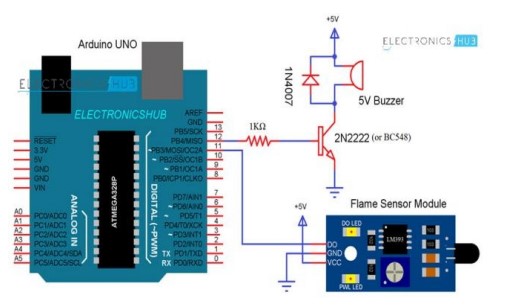
- A flame detector is a sensor intended to identify and react to the presence of a fire or fire.
- The Flam sensor is the sensor that acts promptly while flam will radiate. This offer sign to the regulator to make a move that condition.
- The yield of this sensor is a simple sign or computerized signal.
- To show the identification of a fire, a bell is utilized.
6. 7805 Voltage Regulator
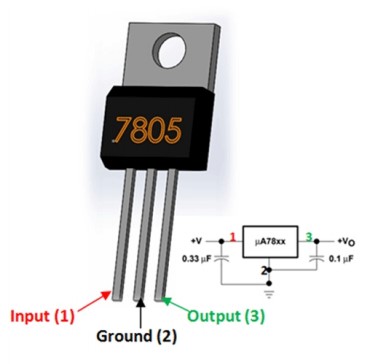
- The voltage controller IC 7805 is really an individual from the 78xx arrangement of voltage controller ICs. It is a fixed direct voltage controller
- The xx present in 78xx addresses the worth of the fixed yield voltage that the specific IC gives. For 7805 IC, it is +5V DC managed power supply. This controller IC additionally adds an arrangement for a warmth sink. The info voltage to this voltage controller can be up to 35V, and this IC can give a consistent 5V for any worth of information not exactly or equivalent to 35V which is as far as possible.
- Batteries give a voltage of 1.2V, 3.7V, 9V, and 12V.
- This voltage is useful for the circuits in which voltage prerequisites are in that reach.
- The 7805 voltage controller is a three-terminal voltage controller IC. In different applications, a 7805 voltage controller with a fixed yield voltage is utilized. The accessibility of this is through different bundles like SOT-223, TO-263, TO-220, and TO-3. Among these, TO-220 is the most utilized one. There are numerous significant highlights in the 7805 IC.
7. Summersible DC Pump
- DC controlled siphons utilize direct current from the engine, battery, or sun based ability to move liquid in an assortment of ways. Mechanized siphons ordinarily work on 6, 12, 24, or 32 volts of DC power.
- The principal benefit of DC (direct current) pumps over AC (exchanging current) siphons is that they can work straightforwardly from a battery, making them more advantageous and convenient.
- They are simpler to work and control since AC frameworks regularly require a controller to oversee speed.
- DC pumps also will in general be more productive.
- Nonetheless, AC siphons for the most part are intended for higher velocities and bigger explosions of force.
IoT based Firefighting System Circuit Diagram
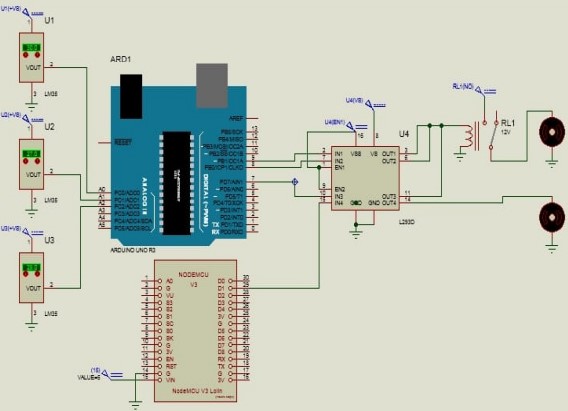
Methodology Used for IoT based Firefighting System
- Automatic farm monitoring
- Auto irrigation system
- Node MCU action
- Flam sensor
Module 1: Automatic farm monitoring
In this section, we continually monitor our farm and surrounding temperature. And send this data to the farmer. Any fire will occur on the outside and inside the farm then automatically water sprinklers will turn on. For achieving this state, we using the Arduino Uno microcontroller and Node MCU.
Module 2: Auto irrigation system
In this project, we continually monitor our farm soil humidity if their humidity is below the set value then automatically water pump will turn on to maintain the humidity in the farm this can be done using a humidity sensor and microcontroller which we mentioned above.
Module 3: Node MCU action
Basically, Node MCU is a controller which is interfacing with the WIFI which gives us to freehand to communicate worldwide. We use this microcontroller to monitor our farm continually.
Module 4: Flame sensor
A Flame sensor is a sensor that acts very immediate while flam will emit. This gives a signal to the controller to take action on that condition.
Requirements Of New Fire Fighting System
The new current fire checking system relies upon a distant sensor network to blend in with the Internet of Things. Taking into account present-day pattern setting advancement, the system limits the mishaps on account of the fire. Sensors distinguish the fire condition and move the data to the structure.
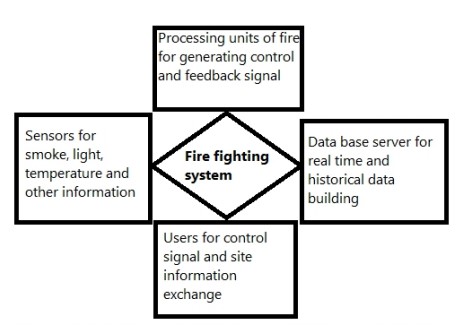
Future Scope
Using real-time data from the weather we can automate our farm. It will help to give an idea to cultivate which type of cultivation is good for next days. Also using the GSM module
we will alert the farmers and respected authorities to take action for any kind of disaster.
Conclusion
At present, there is no other system is present to tackle this kind of disaster. It will give worldwide connectivity which gives us free hands. Hence, we conclude that by using this system we can tackle the condition and prevent our farm from the fire also we will doing automation in irrigation so we will save the water.
Firefighting IOT standard system construction can be accelerated, and a nationwide IoT platform can be constructed by actively carrying out system integration and information sharing of fire-fighting remote monitoring systems.
The IoT technology improves the fire-fighting safety management work from traditional fire-fighting to modern fire-fighting.
This paper discusses the design concept and construction of the fire fighting IOT model and the steps to be followed to do fire-fighting safety management IOT design.
The development of wireless sensors networks with the integration of the Internet of Things arise
challenges in fire-fighting fields. This new approach gives a reliable solution that can permit to detection of fires risks, to avoid severe damage of this disaster when it happens.
References
- Dr. Narayan G. Hegde, “Water Scarcity and Security in India”, BAIF Development Research Foundation, Pune.
- Marvin T. Batte, “Changing computer use in agriculture: evidence from Ohio”, Computers and Electronics in Agriculture, Elsevier science publishers, vol. 47, 1–13, 2005.
- Csoto, Magyar, “Information flow in agriculture –through new channels for improved effectiveness”, Journal of Agricultural Informatics 1 (2), 25–34, 2010.
- Ransing, Rasika S., and Manita Rajput. “Smart home for elderly care, based on Wireless Sensor Network.” 2015 International Conference on Nascent Technologies in the Engineering Field (ICNTE). IEEE, 2015.
- Islam, Taoufikul, Hafiz Abdur Rahman, and Minhaz Ahmed Syrus. “Fire detection system with indoor localization using ZigBee based wireless sensor network.” 2015 International Conference on Informatics, Electronics & Vision (ICIEV). IEEE, 2015.
- Muheden, Karwan, EbubekirErdem, and SercanVancin.”Design and implementation of the mobile fire alarm system using wireless sensor networks.” 2016 IEEE 17th International Symposium on Computational Intelligence and Informatics (CINTI). IEEE, 2016.
- Ogudo, K.A.; Muwawa Jean Nestor, D.; Ibrahim Khalaf, O.; DaeiKasmaei, H. A Device Performance and Data Analytics Concept for Smart phones’ IoT Services and Machine-Type Communication in Cellular Networks. Symmetry 2019, 11,593.
- Zhang, Lei, and Gaofeng Wang. “Design and implementation of automatic fire alarm system based on wireless sensor networks.” Proceedings. The 2009 International Symposium on Information Processing (ISIP 2009). Academy Publisher, 2009.
Credit: This project “IoT Based Firefighting System To Protecting Farm” was completed by Aditi A. Kulkarni, Sweety A. Nargunde, Ruksana A. Mulla, Karishma D. Kate, and Kartik K. Nikam, students of the Department Of Computer Engineering, ATS SBGI, Miraj, Maharashtra, INDIA.

Leave a Reply